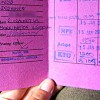Ideally I would have taken the 6 am bus from Chiang Rai to the border town of Mae Sai to enter Myanmar. Instead, I got on the bus around 8 am and didn’t arrive at the border until midday. Both sides were teaming with stalls selling everything from souvenirs to spices. Lines snaked out of the Burmese border control booth, meanwhile people jumped over the fencing and crossed the river by foot–right under the nose of uninterested guards. The Shan State of Myanmar is the largest state or division in the country. It was ruled by the Sao pha long (Sky Lord) until 1947 when it signed an agreement in 1947 granting the state semiautonomous status from Burmese rule. Since then there has been a lot of tension between the state and Yangon. An active military remains intact under a ceasefire and warlords operate in the opium growing regions including Kengtung–considered “the capital of the golden triangle.” As recent as 2001 fighting nearby has closed the border. If you look on a map it is clear to see why this area where Myanmar, China, Thailand and Laos converge is strategic for trade
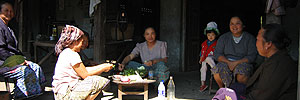
What all this military drama leads to is a lot of red tape for me. The border was open and very eager to take tourists’ $5 for a one day pass. I thought the ride to Kengtung took seven hours from the border but apparently the road has been resurfaced, bringing the journey down to three hours. Still, it would not be possible for me to go to Kengtung and back in one day so I appealed to the border officials for a three-day pass. I had to fill out pages of forms and explain why I wanted to go to Kengtung. After the initial interrogation I was sent, with a handwritten note, across the border to get three photos taken for my visa. Because I am always prepared, I had two photos with me but I suspect that even if I had three I would have still been asked to get new photos taken.
After my photo session I made my way back to the border and an employee took me to another office where I was interviewed by a military official in full uniform. I was then told to give him $10 (U.S. cash only). At this point I was told my passport would be held at the border until I returned. I was granted a 15-day visa with the stipulation that I was only allowed to visit Kengtung. Because all of the buses had left (and it was not clear that I was allowed to ride the local bus anyway) I needed to find a taxi to take me to Kengtung. The border officials said that it should cost around 300-400 Thai Baht ($8-10) so I had a good idea where to start bargaining. I was immediately mobbed by a crowd of tuk-tuk and rickshaw drivers and was completely overwhelmed. Back at the border, a woman told me to take the public bus to the bus station where it would be easier to find a driver. As I attempted to flag the bus down a man approached me and said he had a car ready to leave with three other passengers.
Part of the reason I was having trouble is most people take taxis early in the morning (hours earlier than I had arrived) and taxis don’t leave until they have at least four passengers. Against my better judgment I decided to give the guy a chance. I waited patiently for thirty minutes while he fidgeted, making phone calls and telling me the car was on the way. When I told him I would only wait 15 more minutes, he got mad. We ended up getting in a shouting match over the U.S. economy–he refused to believe that there are homeless people in America. “The dollar is king!” he shouted into the air. As time passed his asking price gradually raised. We had agreed on 300 Baht until he casually mentioned “very cheap for you, maybe only 400… 350 Baht… cheap for you, American.” As I started to walk off a car pulled up with two older women. This was my car, but before I could get in it drove off again. When it came back it was empty and I was suspicious. The driver and I walked back to the border to have him certified to transport me. He had his license photocopied and filled out as many forms as I had for my visa. Finally, three hours after arriving at the border, I was ready to start the journey to Kengtung.
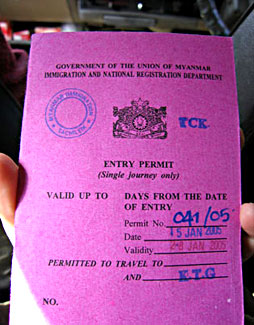
The cover of my Shan State travel permit.
We only made it as far as the bus station when we parked in a lot full of other taxis–waiting for more passengers. Luckily we only had to wait about thirty minutes to find enough people to make the trip. We stopped five times at checkpoints during the three hour trip–sometimes just to get my permit stamped and other times to have all of the passengers’ IDs examined. The military presence on the road was shocking. Although I told the driver where I wanted to stay I was taken to a more expensive hotel. I had to refuse to get out of the car before he would move. Finally, I found the hotel–the only place in town priced under $10 a night. I was shown a $10 room which I turned down for the $5 cold water bungalow.
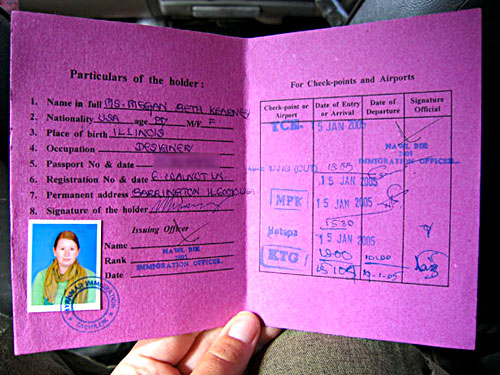
The inside of the permit shows how many checkpoints I went through between Tachileik and Kengtung.
It was getting dark and the owner took me into town on his motorbike for some Chinese food. After eating I started back to the hotel–located in a village outside of Kengtung–in the dark. Kind locals pointed me in the right direction but I was weary after walking 25 minutes and seeing no landmarks. The dirt road began to get rough with potholes and rocks and none of the buildings nearby had lights on. As I started to turn around a woman with a flashlight walked by and told me (in not so many words) that I was walking in the right direction. I continued on and reached the hotel after 45 minutes. Walking down the dark, dirt road alone was scary at the time but I continually reminded myself that things like this always work out in the end.
I spent my first full day in Kengtung getting my bearings and visiting the wats and Buddhist monasteries around town. The layout of the town is very strange–it took me three days before I found the lake in the center of town. Everyone staying at my hotel was quite older and had been to Myanmar before. I only saw about ten other Westerners in town during my five day stay. It was a surreal time, I felt very alone and strange. I only brought a few pieces of clothing, a toothbrush, soap, my sketchbook and iPod with me to Myanmar–leaving the rest in Chiang Rai, Thailand. Kengtung was very cold at night. When the sun went down the town closed. I had to make sure I got some food before 6 pm when the restaurants closed. By 8 pm I was usually in bed, electricity was shut off by then and it was too cold to sit outside. Wearing all the clothes I brought with me and curled up under the covers I listened to The Postal Service on my iPod until I fell asleep.
After a day or two decided to get out of Kengtung and see some of the smaller towns to the North. Renting a heavy, Chinese bicycle I was soon surrounded by rice patties, beautiful skies and mountains in the distance. The small dirt road was fairly busy with a truck or motorbike passing every few minutes. Most people looked back in shock when they realized I was a Westerner. I just smiled and kept pedaling. The road was a bit sandy but I only fell off the bike once. Those Chinese bikes are hard to control and heavy to catch when tumbling off. People seemed shocked and a little giddy to see me in their tiny villages. No one spoke English in these towns but everyone was nice and smiled and welcomed my photography.
One woman posed for me with her pigs who were roaming in her front yard. They had triangle-shaped bamboo fastened around their throats so they couldn’t squeeze out of the fence. Her neighbor brought a small boy out to greet me and showed him how to bow to me with his hands pressed together in greeting.
Near a more developed town (there were permanent structures, not just bamboo huts) a woman ran out of her house and waved me inside. Although I was tired and had been riding for three hours I decided to see what the inside of her house looked like. She happily went about clearing a stool for me around the table where her friends were sitting. They were eating a snack of some sort which may or may not have been a form of betel. My host pointed to a large bowl of greens and went ahead demonstrating how to eat it. She took a leaf, smeared some reddish-brown paste onto it, a bit of sugar and placed a tiny lime (rind and all) on top. She then folded it up into a small ball which she wrapped more stringy leaves around to hold it together.
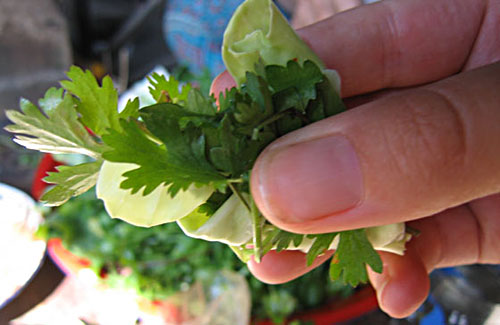
Betel nut? Food? I’m not quite sure, but I ate it to be polite.
I took a small bite and they all broke into laughter. They made it clear I was supposed to stick the entire thing in my mouth. Two of the women demonstrated for me and pointed to my camera.
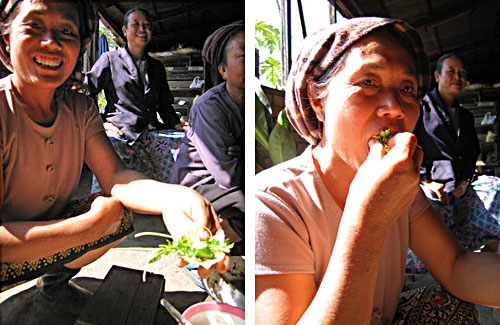
Woman demonstrating eating style.
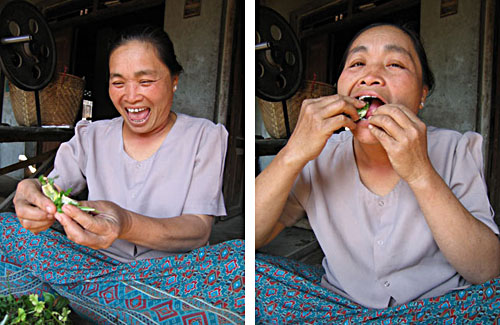
The ringleader who insisted I wasn’t eating it right demonstrates by sticking it beside her cheek.
Sticking the leaves inside my mouth, I bit down and tears came to my eyes. Lime juice poured into my mouth and I chewed on the large sugar crystals, trying to swallow it as quickly as I could. Thankfully, I had some water in my bag and washed it down before throwing up. Spitting it out did cross my mind but I didn’t want to be impolite. I shared a bag of corn shacks with the group and passed around my postcard of Chicago. We spent a lot of time laughing at ourselves and comparing the hair on our arms. It was an amazing experience and we learned a lot about each other without speaking. This is what happens when you explore a bit and allow yourself to be open to new experiences.
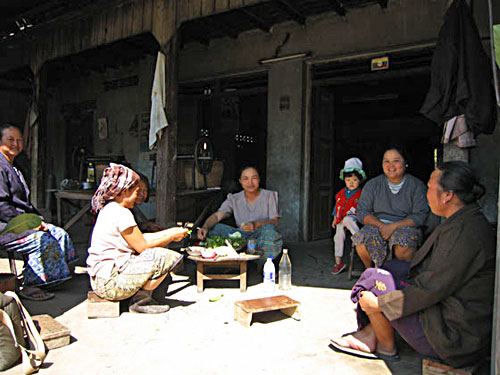
My friends North of Kengtung. That’s my tiny stool in the front.
Walking around town I finally found the lake and some of the landmarks I had seen from a distance. One of the more prominent wats is on top of a hill where I saw a huge standing Buddha pointing toward the mountains. Wandering around I asking for the big Buddha I finally found it–right next door to a Catholic mission. Legend says the town was founded on the hill where the mission stands. Besides the church, a stage, and school there is a large orphanage. The standing Buddha is still under construction (explaining why I hadn’t heard of it before) and obviously built in reaction to the Catholic presence on the hill.
The Christian presence in town was fairly shocking to me–Myanmar could be called the “most Buddhist” of any country. For some reason, missionaries concentrated on Kengtung, erecting the huge Catholic complex as well as a number of Baptist churches and a convent. Most of the people who were forward enough to approach me started off by saying something like “Hi, I’m Christina and I’m a Christian.” I found this behavior very odd and a bit suspicious. It turned out they were nice people and after four or five tries they revealed their “real” name to me. Christina’s Burmese name was something that sounded like bo-bo. I had a lot of fun playing around with them. They wanted to talk about Christianity and I told them I wasn’t Christian. This shocked them. When I replied that I wasn’t Buddhist either they didn’t know what to do with me.
I was approached by another Christian when I was sitting by the lake. Although I just wanted to be left alone to admire the view he wanted to talk to me about Western culture. He wanted to know what it was like to live in England and how much money he would need to fly there. I got a little information out of him as well, mostly about the corruption and bribery involved in owning a motorbike or (if you’re rich) a car. He also explained why there was a large fence around the lake. Most bodies of water in Asia are filled with fishermen, kids playing and women doing laundry but this lake was completely empty. He explained that there used to be a floating nightclub in the middle of the lake. After too many fights broke out the government banned anyone from entering the lake and erected a fence. This demonstrates the way in which problems are handled in Myanmar.
Before I left town I decided to seek out some of the smaller wats which were supposed to have rare statuary. Walking down a steep hill I met an old man who offered to show me to the wat I was looking for. I only wanted to be pointed in the right direction but gained a tour guide. This kind of hospitality is typical in Myanmar. Unfortunately, it meant I couldn’t wander around unannounced or sit down to drawn without offending the man. He clearly wanted to show off his English so I followed him around. Since he spoke such good English I asked him to take my cartwheel picture (for those who don’t know me, I take a photo of myself doing a cartwheel in every city). I quickly regretted it when he first thought I was giving him the camera as a present and then tried to take the photo with the lens facing him. Trying to leave, I shook his hand and he wouldn’t let go. After a bit of awkward silence he laughed and said “yes, you are very fat!” I knew this was considered a compliment in Myanmar so I laughed along and managed to free my hand and thank him for his hospitality.
My final task before leaving Kengtung was to buy some tribal handicrafts. I had visited the huge morning market earlier in the week to see what was available and get ballpark prices. I ended up buying from two different stalls. One woman sold me a beautiful embroidered Akha jacket for $30 and one headdress for $25. After some hard bargaining I was able to get the second woman to sell me a different style of Akha headdress for the same price. The Akha headdresses I saw in Thailand were a joke compared to these. These were intricately decorated with real coins and handstiching. In Thailand the headdresses have a few bobbles sewn on with what looks like machine stitching across the front. I was very pleased with my purchases, even if they seemed extremely expensive at the time.
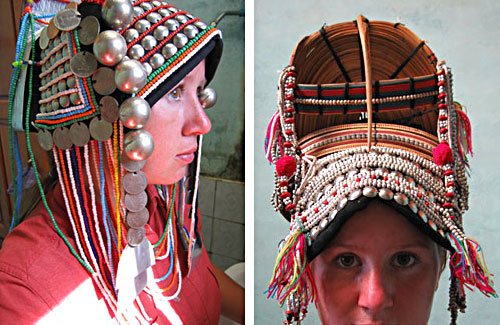
The two Akha headdresses I bought at the market.
My taxi to the border left by 10 am, only two hours late, and I was happy to get back to Thailand and all of the Western food I could eat. I had to sit in the middle between two men who turned out to work for the government. They were quite nice and spoke a bit of English. We were delayed by one flat tire on the side of a mountain in the middle of nowhere and then, by the driver’s lunch break. The military happily handed my passport back at the border, not asking to see my bags or ask what I had purchased. The trip was definitely worthwhile and peaked my interest in Myanmar–after this I knew I had to see the rest of the country.
You can see the photos from Kengtung here.
